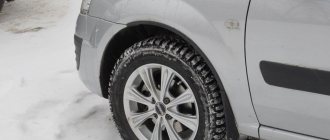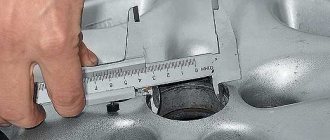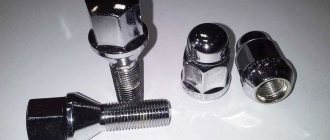How to measure the drill hole (PCD) of a wheel rim?
Very often we are asked the question of how to correctly measure one of the main parameters of a wheel rim - its drilling (aka PCD). And today we will answer this question in detail.
PCD (Pitch Circle Diameter) - the diameter of the location of the centers of the holes for fasteners on the wheel rim. A couple of examples: 5x114.3 - 5 holes located on a diameter of 114.3 mm; 3x112 - 3 holes, which are located on a diameter of 112 mm; 4x108 - 4 holes with a diameter of 108 mm; 6x139.7 - 6 holes on a diameter of 139.7 mm.
Measuring the drilling of a 4 or 6 bolt wheel rim is not difficult, you just need to measure the distance between the centers of opposite holes.
However, measuring the drilling of a 5-bolt disk is a more non-trivial task, because there are no opposite holes (we consider the opposite hole to be the hole whose chord to the center passes through the center (!) of the wheel disk).
We strongly DO NOT recommend using methods widely used on the Internet with one measurement and further multiplying the resulting value by a certain coefficient - with a 99% probability you will get the wrong value.
So, to measure the drilling (PCD) of a 5-bolt disk, you need to take two measurements and then add the two obtained values.
Due to its specific nature, we will, of course, carry out measurements on a wheel spacer, and not on a wheel rim, but this does not change the essence at all.
Measurement No. 1: distance from the inner edge of one of the 5 holes to the central hole (DIA) of the wheel rim:
The result of our measurement is
20.0mm
Measurement No. 2: the distance from the outer edge of one of the 5 holes to the opposite side of the central hole (DIA) of the wheel rim:
The result of the second measurement is 92.0mm :
We add the two obtained values: 20.0 + 92.0 = 112mm Thus, drilling the wheel rim (spacer-adapter in our case) has a value of
5x112 (where “5” is the number of holes, “112” is the diameter of their centers in millimeters).
Let's consolidate the knowledge gained with one more example. This time we will take measurements not with a caliper, but with a regular ruler .
We measure the distance from the inner edge of one of the holes (any) to the CO (central hole, DIA):
Result: 20.0 mm
Next, we measure the distance from the outer edge of one of the holes (again, any) to the opposite side of the CO.
Make sure that the ruler passes strictly through the center of the wheel rim! We get: 92.0mm
Add: 20.0 + 92.0 = 112mm, i.e. in this case, the value of the measured drilling is still the same 5x112 !
Drilling is determined!
Main settings
There are several main sizes that play a key role in choosing the right and suitable wheels for each specific car. If you make a mistake on even one of them, the kit simply will not fall into place. The machine cannot be operated on wheels whose parameters do not meet the stated requirements and design features. Before trying on a bolt pattern, every motorist should know what exactly he has to measure, and what dimensions play the main role. We are talking about the following main sizes:
- the number of bolt holes on which the wheel is installed (indicated by the letters LZ in the marking);
- the distance provided between bolt holes;
- the diameter of the circle where the holes for the mounting wheel bolts are located, PCD marking is used;
- indicator of the diameter of the hub or central window: both concepts are found, but they are essentially synonymous, this parameter is marked with the letters DIA;
- overhang size, this value can be easily recognized by the ET marking.
It should be understood that each of these parameters, the presence of which is provided by the bolt pattern, is extremely important in the matter of choosing suitable wheels. Therefore, you need to carefully approach the purchase so that you don’t have to change the kit, overpay for delivery and simply waste time searching. If we talk about passenger vehicles, then the number of windows for mounting bolts can range from 3 to 6 units. Trucks have many more of them. Basically there are from 12 to 15 windows. The domestic auto industry, which is based on AvtoVAZ, uses 4 inlet holes for mounting bolts. The only exception was the legendary Niva, on which 5 mounts were installed. Only the holes can be counted the easiest. To do this, just take a visual look at the car. You can easily see exactly how many bolts are used to secure the wheel.
Read more: Wheel nuts chevrolet cruze
How to measure the bolt pattern on 5-hole rims
The diameter at which these mounting holes are located (PCD) Counting the number of holes for the bolts is not a problem; usually there are 3, 4, 5 6 8 10.
The diameter at which they are located is sometimes “knocked out” from the inside of the disk, as shown in the pictures
Unfortunately, sometimes it is not very clear where exactly these PCD value numbers are written, since each disk manufacturer may write them in different places or not write them at all. Therefore, we will need a Vernier caliper or a regular ruler.
You need to measure the distance between the centers of the far holes located opposite each other, as shown in the pictures (the necessary comments are signed under the pictures)
For disks with five (Fig. 1) mounting holes: PCD is equal to the distance between the centers of the farthest (any non-adjacent) bolts or nuts multiplied by a factor of 1.051 In our case, 95x1.051 = 100 mm
For disks with four (Fig. 2) or six mounting holes: PCD is equal to the distance between the centers of the farthest (opposite) bolts or nuts. In our case, also 100 mm.
Attention! Measurements must be carried out with high accuracy, since there are very close values (for example, 98 and 100 or 110 and 112) and which cannot be used instead of others!
For greater confidence in measurements, we provide a table of the applicability of various PCD values to car brands. For example, if you have a Mercedes car, and the measurement turns out to be 111 mm, then the real value is 112 mm, since Mercedes does not make wheels of either 110 or 111 mm.
Fig1 Diameter on which these mounting holes are located (PCD) Counting the number of holes for bolts is not a problem; usually there are 3, 4, 5 6 8 10.
Fig2-3 The diameter at which they are located is sometimes “knocked out” from the inside of the disk, as shown in the figures
Fig4 For disks with five (Fig. 1) mounting holes: PCD is equal to the distance between the centers of the farthest (any non-adjacent) bolts or nuts multiplied by a factor of 1.051 In our case, 95x1.051 = 100 mm
Fig.5 For disks with four (Fig. 2) or six mounting holes: PCD is equal to the distance between the centers of the farthest (opposite) bolts or nuts. In our case, also 100 mm.
How to measure the drill hole (PCD) of a wheel rim?
Very often we are asked the question of how to correctly measure one of the main parameters of a wheel rim - its drilling (aka PCD). And today we will answer this question in detail.
PCD (Pitch Circle Diameter) - the diameter of the location of the centers of the holes for fasteners on the wheel rim. A couple of examples: 5x114.3 - 5 holes located on a diameter of 114.3 mm; 3x112 - 3 holes, which are located on a diameter of 112 mm; 4x108 - 4 holes with a diameter of 108 mm; 6x139.7 - 6 holes on a diameter of 139.7 mm.
Measuring the drilling of a 4 or 6 bolt wheel rim is not difficult, you just need to measure the distance between the centers of opposite holes.
However, measuring the drilling of a 5-bolt disk is a more non-trivial task, because there are no opposite holes (we consider the opposite hole to be the hole whose chord to the center passes through the center (!) of the wheel disk).
We strongly DO NOT recommend using methods widely used on the Internet with one measurement and further multiplying the resulting value by a certain coefficient - with a 99% probability you will get the wrong value.
So, to measure the drilling (PCD) of a 5-bolt disk, you need to take two measurements and then add the two obtained values.
Due to its specific nature, we will, of course, carry out measurements on a wheel spacer, and not on a wheel rim, but this does not change the essence at all.
Measurement No. 1: distance from the inner edge of one of the 5 holes to the central hole (DIA) of the wheel rim:
Measurement No. 2: distance from the outer edge of one of the 5 holes to the opposite side of the central hole (DIA) of the wheel rim:
The result of the second measurement is 92.0mm :
We add the two obtained values: 20.0 + 92.0 = 112mm Thus, drilling the wheel rim (spacer-adapter in our case) has a value of 5x112 (where “5” is the number of holes, “112” is the diameter of their centers in millimeters).
Let's consolidate the knowledge gained with one more example. This time we will take measurements not with a caliper, but with a regular ruler .
We measure the distance from the inner edge of one of the holes (any) to the CO (central hole, DIA):
Next, we measure the distance from the outer edge of one of the holes (again, any) to the opposite side of the CO. Make sure that the ruler passes strictly through the center of the wheel rim!
Add: 20.0 + 92.0 = 112mm, i.e. in this case, the value of the measured drilling is still the same 5x112 !
One of the main parameters of wheel rims is the number of mounting holes and their location relative to the wheel axis. The English term PCD, in domestic auto slang called a bolt pattern, contains information about the number of studs or bolts, as well as the diameter of the circle in which their centers are inscribed.
For example, a typical size for VAZ cars will be designated as PCD 4 x 98 .
5 main wheel sizes
The most common wheels are found, except for those that came from old FIAT models and some other cars, VAZ PCD 4 x 98 , with 4 and 5 bolts (studs).
The most popular bolt patterns:
Although it is difficult to judge the actual prevalence of specific sizes, there are many others used on fairly well-known mass-produced cars.
Naturally, the disc parameters are not limited by the size of the bolt pattern.
There are others, no less important:
- diameter of the central hole;
- width;
- departure;
- disc edge parameters and much more.
How to measure the bolt pattern of a disc yourself
In fact, the need for measuring procedures rarely arises. The required parameter can be easily found out from the characteristics of a particular machine, and for any disk it is indicated on the product labeling.
But the designation of a used part may have been destroyed, so you will have to determine the bolt pattern using a ruler.
Measurements should be made with the greatest possible accuracy. It is very difficult, for example, to distinguish a 4x98 disk from a 4x100 one. It often happens that VAZ cars are driven with enlarged PCD rims, which is wrong and very dangerous.
Even if the wheel is centered more or less normally and does not bounce while driving, the lack of complete contact between the chamfers of the fastening bolts and the disk sockets causes high stress in the metal, wear of the holes, fatigue in the wheel bolts and a high probability of losing the wheel while driving.
There are two measurement methods - for an even number of studs and universal.
If the number is even, it is enough to mark the centers of the holes with the greatest possible accuracy and determine the distance between these centers for diametrically opposite bolts.
You will have to use a caliper; a regular ruler will give too much error. For example, on a disk you need to take the size between the edges of the holes, one from the inside, the other from the outside. Since the diameters of the bolt sockets are made with high precision, this will be the desired PCD.
Calculation formula and compatibility tables
If there are an odd number of holes, one measurement will not work. In this case, you need to measure the distance between the axes of two adjacent bolts, and then apply simple formulas for calculations.
Let's say the distance is equal to some number X. Then, depending on the number of bolts from 3 to 5, the following formulas are used:
- 3 bolts. PCD=1.155*X
- 4 bolts. PCD=1.414*X
- 5 bolts. PCD=1.701*X
The formulas are obtained as a result of simple geometric manipulations; everyone can personally check and obtain more accurate coefficients.
As approximate reference information, you can use the table of compatibility of car models based on the same PCD.
As mentioned above, this cannot in any way mean complete interchangeability of disks, since all their other parameters rarely coincide.
| Disc size according to PCD | The most common cars where it is used |
| 4×98 | Alfa Romeo 33, 155, 164, FIAT 124, 126, Brava, Cinquecento, Croma, Multipla, Palio, Panda, Punto, Seicento, Tempra, Tipo, Uno, Lancia Delta, Lada |
| 4×100 | Old models Audi, Mini, BMW 3, Daewoo Espero, Lanos, Nexia, Daihatsu Charade, Cuore, Grand Move, Honda CRX, Civic, Accord, Integra, Jazz, Kia Spectra / Sephia, Mazda 121, 323, MX5, Mitsubishi Carisma, Colt, Lancer, Nissan Micra, Sunny, Opel Ascona, Astra, Calibra, Corsa, Kadett, Vectra, Zafira, Renault Clio, Espace, Kangoo, Megane, Twingo, Seat Ibiza, Toledo, Skoda Felicia, Suzuki Baleno, Toyota Corolla, Yaris , Volkswagen Golf, Jetta, Passat, Polo, Volvo 440 |
| 4×108 | Audi 80, 100, Citroen BX, ZX, Berlingo, Visa, Xantia, Xsara, Ford Escort, Fiesta, Ka, Mondeo, Peugeot 106, 205, 206, 306, 307, 405, 406, Partner, Saab 900, 9000, Volvo 850 |
| 4×114,3 | Daewoo Matiz, Honda Civic VTEC, Accord, Prelude, Hyundai Accent, Sonata, Mitsubishi Carisma, Colt, Galant, Lancer, Space Wagon, Nissan Almera, Primera, Suzuki Alto, Swift, Volvo S40, V40 |
| 5×100 | Audi A3, TT, Skoda Octavia, Subaru Forester, Impreza, Legacy, Outback, Toyota Avensis, Carina, Celica, Volkswagen New Beetle |
| 5×108 | Citroen XM, Jumper, Ferrari, Ford Focus, Mondeo, Volvo 740, 760, 780 |
| 5×112 | Audi 100 CS, Quattro, Audi A4, S2, S4, A6, A8, Ford Galaxy, Mercedes Benz 280SL, 600SL, SLK, A, Vito, Volkswagen T1, T4 |
| 5×114,3 | American cars, Daihatsu Terios, Honda Odysee, CRV, Lexus, old Mazda models, Toyota RAV4 |
| 5×115 | American cars |
| 5×120 | Range Rover, Rolls Royce |
| 5×139,7 | Lada 4×4, Chevrolet Niva, UAZ |
It should be borne in mind that the wheels that were equipped with the cars could differ greatly depending on the specific modification of the model and the equipment ordered.
How to measure wheel bolt pattern
How to measure the bolt pattern of a disk The diameter at which these mounting holes are located (PCD) Counting the number of holes for the bolts is not a problem; usually there are 3, 4, 5 6 8 10.
The diameter at which they are located is sometimes “knocked out” from the inside of the disk, as shown in the pictures
Unfortunately, sometimes it is not very clear where exactly these PCD value numbers are written, since each disk manufacturer may write them in different places or not write them at all. Therefore, we will need a Vernier caliper or a regular ruler.
You need to measure the distance between the centers of the far holes located opposite each other, as shown in the pictures (the necessary comments are signed under the pictures)
For disks with five (Fig. 1) mounting holes: PCD is equal to the distance between the centers of the farthest (any non-adjacent) bolts or nuts multiplied by a factor of 1.051 In our case, 95x1.051 = 100 mm
For disks with four (Fig. 2) or six mounting holes: PCD is equal to the distance between the centers of the farthest (opposite) bolts or nuts. In our case, also 100 mm.
Attention! Measurements must be carried out with high accuracy, since there are very close values (for example, 98 and 100 or 110 and 112) and which cannot be used instead of others!
For greater confidence in measurements, we provide a table of the applicability of various PCD values to car brands. For example, if you have a Mercedes car, and the measurement turns out to be 111 mm, then the real value is 112 mm, since Mercedes does not make wheels of either 110 or 111 mm.
The diameter at which these mounting holes are located (PCD) Counting the number of holes for the bolts is not a problem; usually there are 3, 4, 5 6 8 10.
The diameter at which they are located is sometimes “knocked out” from the inside of the disk, as shown in the pictures
For disks with five (Fig. 1) mounting holes: PCD is equal to the distance between the centers of the farthest (any non-adjacent) bolts or nuts multiplied by a factor of 1.051 In our case, 95x1.051 = 100 mm
For disks with four (Fig. 2) or six mounting holes: PCD is equal to the distance between the centers of the farthest (opposite) bolts or nuts. In our case, also 100 mm.
Disc size indicators
There are five main sizes, an error in determining which will result in the impossibility of installing the wheel.
The number of windows for bolts on passenger cars varies from 3 to 6. For trucks, this figure reaches 12-15 pieces. Togliatti-made cars have 4 bolt entries. The exception is the Lada Niva, the wheels of which are secured with five bolts each. The number of holes is measured visually by simple counting.











